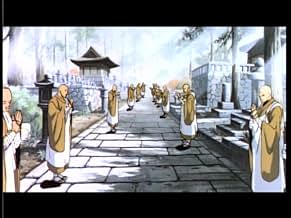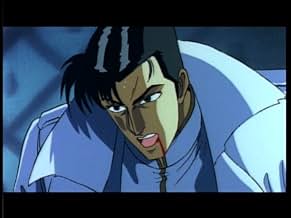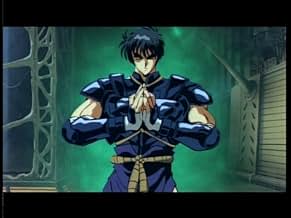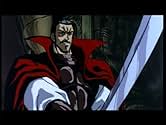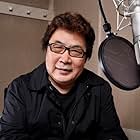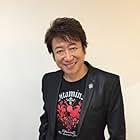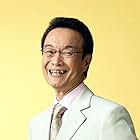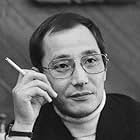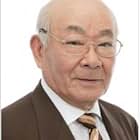Peacock King: Spirit Warrior - Castle of Illusion
Original title: Kujaku ô 2: Genei-jô
- Episode aired Jul 1, 1989
IMDb RATING
6.8/10
29
YOUR RATING
Can Kujaku and his friends find a way to stop the 6th king of evil from resurrecting a demon that will through the world in to chaos?Can Kujaku and his friends find a way to stop the 6th king of evil from resurrecting a demon that will through the world in to chaos?Can Kujaku and his friends find a way to stop the 6th king of evil from resurrecting a demon that will through the world in to chaos?
Stacie Johnsen
- Ranmaru
- (as Stacie Kellie)
- …
James Stanley
- Siegfried von Mittgard
- (English version)
- (voice)
Dan Truman
- Ko
- (English version)
- (voice)
Chikao Ôtsuka
- Nobunaga Oda
- (as Chikao Ohtsuka)
- Director
- Writer
- All cast & crew
- Production, box office & more at IMDbPro
Storyline
Featured review
CASTLE OF ILLUSION (1989) is the second installment of the popular anime series of occult thrillers based on the "Peacock King" manga (comic book) by Makoto Ogino. Like the first volume, FESTIVAL OF OGRES' REVIVAL, it draws on a figure from Japanese history to depict a modern-day battle of light and dark, old vs. new. Here the figure is Oda Nobunaga, a famous general from the 16th century Warring States period described here as the "biggest heretic in the history of Buddhism" in the English dub and "the greatest enemy of Buddhism" in the Japanese original. Nobunaga was a key figure in the unification of Japan, a process completed by Ieyasu Tokugawa (who is invoked in Volume 3: A HARVEST OF CHERRY BLOSSOMS), but is often portrayed as a villain in Buddhist-friendly anime because his most horrific act was the slaughter of a thousand monks on Mount Hiei.
This volume begins as occult researchers retrieve an old painting of Nobunaga's Azuchi Castle, an act which revives a set of evil-intended "tenshi" or "angels" who perform a ritual to revive Nobunaga by possessing the body of young female researcher Tatsuko. In the course of it all, Nobunaga's massive sunken castle rises from Lake Biwa and the stage is set for the final battle between our intrepid ghost hunter heroes and Nobunaga and his minions. The main hero, Kujaku, the young Buddhist monk who is a reincarnation of the Peacock King of ancient lore, is joined by his allies from Volume 1, Ashura, his pretty young sidekick, and Onimaru, the biker warrior/spirit mercenary of forbidden curses. They gain a new ally in Kaiho Ko, a spirit warrior of the Chinese Ko family who will appear in two later volumes.
The most controversial aspect of this piece is the equation of Nobunaga's dabblings in European culture and Christianity with evil. The revived Nobunaga keeps invoking "The Will of God" and his big mission at Azuchi Castle is to raise an army of "Cherubim," massive pink, gummy, worm-like monsters described at one point as "the holy beasts of the God of the Bible." This is pretty strong stuff, although fans of occult-themed anime are either not easily offended by such concepts or tend to understand the cultural patterns behind them. The whole story gets incredibly complicated and comes with a large cast of characters and a dizzying array of supernatural entities and revived spirits. (The script is by Noboru Aikawa, who's also known for his work on VAMPIRE PRINCESS MIYU and THE HAKKENDEN.) The English-dubbed version tries to simplify things but may wind up causing some confusion.
This is the most over-the-top of the Peacock King series thanks to a steady stream of monsters and grotesque entities threatening the heroes and the picturesque city of Kyoto. The violence and gore are pretty constant and include such sights as dismembered bloody corpses transforming into skeletal insect-like monsters which then attack Hannoji Temple in Kyoto, the site of Nobunaga's assassination in 1582. The Cherubim are pretty scary creatures themselves, with gaping, devouring jaws and rows of sharp teeth and long slimy necks protruding from their egg sacs. (The Cherubim were designed by Screaming Mad George, a Japanese live-action special effects wiz who has worked mostly in the U.S.) There is gratuitous nudity, but no sexual content, as there is in other volumes; Ashura is completely nude throughout the final battle.
It's a wild, thrilling ride for fans of the genre and is packed with intriguing historical and cultural detail. It's expertly animated and beautifully designed and drawn. The character design is marked by sharp features and bold lines and looks more like traditional manga design than that in the other volumes. The backgrounds in Kyoto and the surrounding countryside are all meticulously rendered, with special attention to the design of Nobunaga's sprawling castle. While the final two volumes (both 1994) are slicker, more polished and more fluidly animated, the artwork is actually better in this installment and more appropriate to the subject. Fans who get squeamish at gruesome imagery or offended by negative views of Christianity may want to avoid this one, although it does represent a Japanese cultural undercurrent that serious students of anime would do well to study.
The other PEACOCK KING volumes include FESTIVAL OF OGRES' REVIVAL, A HARVEST OF CHERRY BLOSSOMS, SPIRIT WARRIOR 1: REVIVAL OF EVIL and SPIRIT WARRIOR 2, all of which are reviewed on this site.
This volume begins as occult researchers retrieve an old painting of Nobunaga's Azuchi Castle, an act which revives a set of evil-intended "tenshi" or "angels" who perform a ritual to revive Nobunaga by possessing the body of young female researcher Tatsuko. In the course of it all, Nobunaga's massive sunken castle rises from Lake Biwa and the stage is set for the final battle between our intrepid ghost hunter heroes and Nobunaga and his minions. The main hero, Kujaku, the young Buddhist monk who is a reincarnation of the Peacock King of ancient lore, is joined by his allies from Volume 1, Ashura, his pretty young sidekick, and Onimaru, the biker warrior/spirit mercenary of forbidden curses. They gain a new ally in Kaiho Ko, a spirit warrior of the Chinese Ko family who will appear in two later volumes.
The most controversial aspect of this piece is the equation of Nobunaga's dabblings in European culture and Christianity with evil. The revived Nobunaga keeps invoking "The Will of God" and his big mission at Azuchi Castle is to raise an army of "Cherubim," massive pink, gummy, worm-like monsters described at one point as "the holy beasts of the God of the Bible." This is pretty strong stuff, although fans of occult-themed anime are either not easily offended by such concepts or tend to understand the cultural patterns behind them. The whole story gets incredibly complicated and comes with a large cast of characters and a dizzying array of supernatural entities and revived spirits. (The script is by Noboru Aikawa, who's also known for his work on VAMPIRE PRINCESS MIYU and THE HAKKENDEN.) The English-dubbed version tries to simplify things but may wind up causing some confusion.
This is the most over-the-top of the Peacock King series thanks to a steady stream of monsters and grotesque entities threatening the heroes and the picturesque city of Kyoto. The violence and gore are pretty constant and include such sights as dismembered bloody corpses transforming into skeletal insect-like monsters which then attack Hannoji Temple in Kyoto, the site of Nobunaga's assassination in 1582. The Cherubim are pretty scary creatures themselves, with gaping, devouring jaws and rows of sharp teeth and long slimy necks protruding from their egg sacs. (The Cherubim were designed by Screaming Mad George, a Japanese live-action special effects wiz who has worked mostly in the U.S.) There is gratuitous nudity, but no sexual content, as there is in other volumes; Ashura is completely nude throughout the final battle.
It's a wild, thrilling ride for fans of the genre and is packed with intriguing historical and cultural detail. It's expertly animated and beautifully designed and drawn. The character design is marked by sharp features and bold lines and looks more like traditional manga design than that in the other volumes. The backgrounds in Kyoto and the surrounding countryside are all meticulously rendered, with special attention to the design of Nobunaga's sprawling castle. While the final two volumes (both 1994) are slicker, more polished and more fluidly animated, the artwork is actually better in this installment and more appropriate to the subject. Fans who get squeamish at gruesome imagery or offended by negative views of Christianity may want to avoid this one, although it does represent a Japanese cultural undercurrent that serious students of anime would do well to study.
The other PEACOCK KING volumes include FESTIVAL OF OGRES' REVIVAL, A HARVEST OF CHERRY BLOSSOMS, SPIRIT WARRIOR 1: REVIVAL OF EVIL and SPIRIT WARRIOR 2, all of which are reviewed on this site.
- BrianDanaCamp
- Aug 7, 2002
- Permalink
Details
- Color
Contribute to this page
Suggest an edit or add missing content


